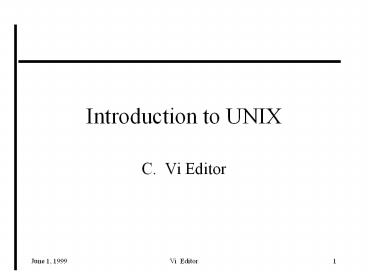Introduction to UNIX - PowerPoint PPT Presentation
1 / 22
Title: Introduction to UNIX
1
Introduction to UNIX
- C. Vi Editor
2
Overview of vi
- Performance Objectives
- 1. Start/End VI (vi, ESC, wq)
- 2. Move the Cursor and Window (h,j,k,l, f, b)
- 3. Insert, Change, Delete Text (i, a, x, dd)
- 4. Search and Replace text (/.../, n,
s/.../.../g) - 5. Move/Copy Text (ma, d'a, p)
- 6. Write and Read Files (w file, r file)
- 7. Tailor the VI Environment (set)
3
UNIX Family of editors
- ex line editor
- ed subset of ex
- vi screen editor
4
Why learn vi/ex?
- Available on most UNIX systems.
- Works with a variety of terminals.
- Needs no special keyboard definition files.
- Allows the use of ex commands from vi.
- Provides for a customized editing environment.
5
Some Conventions
- vi commands do not require a ltCRgt.
- vi commands not echoed.
- ex commands begin with / ?
- ex commands are echoed and ended with a ltCRgt
- The character represents the ltctrlgt key.
6
Vi Modes
- COMMAND mode
- The default mode on entering vi.
- Anything typed is interpreted as a command.
- INSERT mode
- Enter INSERT mode by typing one of several
commands. - Anything typed is interpreted as data.
- Exit INSERT mode by typing the ltESCgt key.
7
Vi Modes
UNIX Shell
vi filename
ZZ or wq
Command Mode
i a o
ltESCgt
Input Mode
8
vi Window Display
Line one Line two Line three Line
n Command line
File text
Null lines
EX cmd line
9
Vi Window Positioning
vi window
f Display Next segment
File
10
Basic Window Positioning
- Move window forward 32 lines f
- Move window backward 32 lines b
- Move window forward one line e
- Move window to line n of file n
- Move window to end of file G
- Move cursor up/dn left/rt
-
or - h
j k l
11
Making Changes Permanent
- vi uses a temp file for changes
- Write file and quit editor wq
- Undo last command u or U
- Recovery vi -r filename
Perm File
Temp File
w
12
Insert/Delete Functions
- Del current line dd
- Del current char x
- Insert before current char i ...
- Insert after current char a ...
- Insert after current line o ... (opens file
at a line)
13
More Vi Functions
- Open several files vi file1 file2 ...
- End editor q (does not save changes)
- Redraw screen l (L)
- Join this line with next J
14
Search For a Pattern
- Search forward to pattern / ... /
- Search backward to pattern ? ... ?
- Advance to next pattern n
(forward or reverse)
15
Replace A Pattern
- Replace string with another s/.../.../
(only on same line) - Replace string (global) 1,s/.../.../g
16
Moving Text
- ma mark the starting position with a
- d'a delete text into a buffer
- p put buffer contents after cursor
ma
Area to be moved
da
Insert location
p
17
Copying Text
- ma mark the starting position with a
- y'a yank text into a buffer
- p put buffer contents after cursor
ma
Area to be copied
ya
Insert location
p
18
Writing to a file
- write current file w
- write named file w
filename - overwrite named file w!
- write lines m - n to named file m,nw file
19
Useful Functions
- Re-edit current file, discard changes e
- Edit named file
e file - Read in and insert file at cursor r
file - Execute command and return to vi !cmd
20
Tailoring the Environment
- For current session set optionsltcrgt
- Example set nu ltcrgt will set line numbers
- To view possible settings
- set all
- noautoindent nonumber noslowopen
- autoprint nonovice tabstop8
- noautowrite nooptimize
taglength0 - nobeautify paragraphs tagstags
/usr/lib/tags - directory/tmp prompt termvt100
- noedcompatible noreadonly noterse
- noerrorbells redraw timeout
- flash remap
ttytypevt100 - hardtabs8 report5 warn
- noignorecase scroll11 window23
- nolisp sections wrapscan
- nolist shell/bin/csh
wrapmargin0 - magic shiftwidth8 nowriteany
- mesg noshowmatch
- nomodelines noshowmode
21
Order of Evaluation
- On startup, vi sets options defined by EXINIT
variable. - Then options defined in /.exrc file.
- Settings in /.exrc take precedence.
- Setting in .exrc file in CWD take precedence over
/.exrc file and EXINIT. - Finally, set options of current session take
precedence during that session.
22
End of Module
Complete VI Editor Exercises































